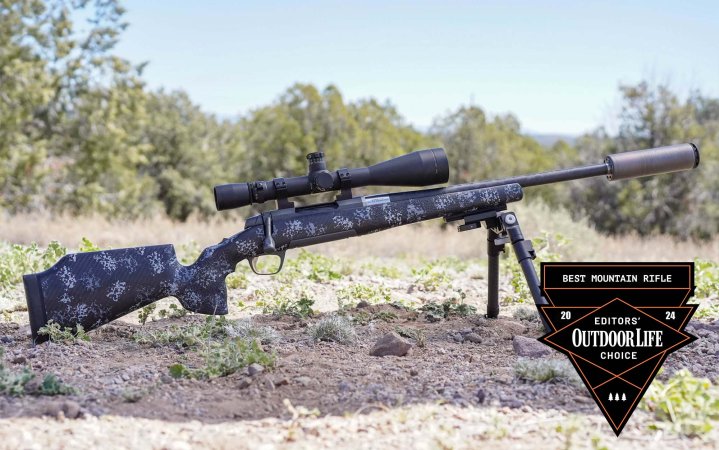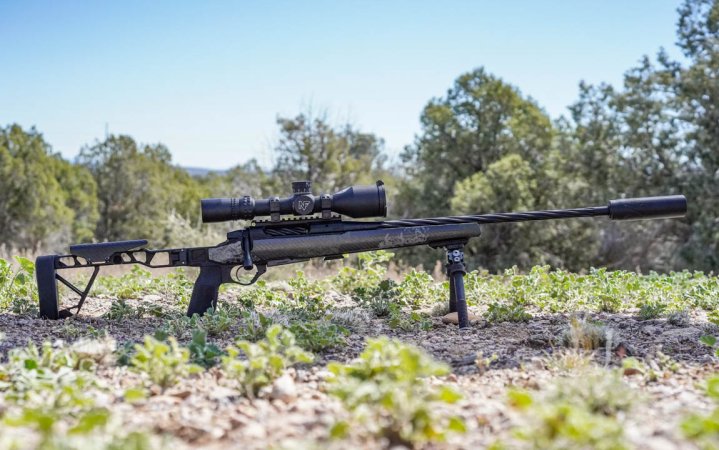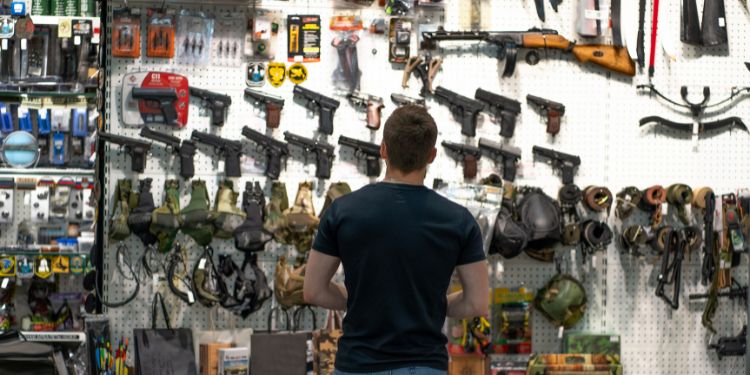The Best Deer Hunting Rifles of 2024

We may earn revenue from the products available on this page and participate in affiliate programs. Learn More ›
I’ve often said that the best deer rifle is the one you already own. That rifle, if not an actual treasure, has one quality that no other firearm can match — the experiences and memories it helped create and that are yours and yours alone.
While owning a single deer gun might give you cred with the old-timers who agree with the adage “beware of the man who owns just one rifle, for he probably knows how to use it” what a dull life that would be.
There are so many good rifles for whitetail and mule deer that it would be a shame to carry just one over your hunting career. And the list of good options has grown significantly in the last year with the introduction of several intriguing new guns.
Whether you are looking to upgrade your deer rifle, or just add to your collection, this list of the best deer rifles is for you.
How I Picked the Best Deer Rifles
I structured the list loosely based on geography and hunting style to give it a bit of variety and to help provide some ammunition to whoever finds themselves arguing with their significant other over the justification for buying a new gun. “But honey, I can’t take that rifle, I’m going hunting in Kansas…”
These are also deer rifles that my colleagues and I have shot, tested, and hunted with and have passed muster. We didn’t include any that we don’t have hands-on experience with. All but one of the rifles are currently in production, and most are affordable, though we threw in a couple that are worth saving for or aspiring to.
But the bottom line is that these rifles are ones you can rely on to handle any deer hunt you might encounter, whether that is on your family’s plot of land in farm country, in the snowy hardwoods in the North Country, in a stand of alpine timber, or in the distant rainforests of coastal Alaska.
Best Deer Hunting Rifles: Reviews and Recommendations
Best All-Around: Sako 90S Adventure
See It
The new Sako 90 Adventure won the hearts of the Outdoor Life gun test team at our annual rifle test, where it earned an Editor’s Choice award as the best hunting rifle of the year. It is a well-balanced, accurate, and thoughtfully designed rifle with some of the finest ergonomics I’ve seen.
If you want to dive into the details, you can read my longer review, but the upshot is that you won’t find a more complete expression of a traditional hunting rifle than the Sako 90 Adventure.
The only ding for some hunters might be its weight. It tips the scales at 6.5 pounds which might be a bit more than some mountain hunters would care to shoulder. If that’s the case, then you can look at the Sako 90 Peak, which trims the better part of a pound from the format.
In terms of cartridge selection, the Adventure is offered in .243 Win., 7mm-08, .308 Win., 6.5 Creedmoor, 7mm Rem. Mag., and .300 Win. Mag. — effective deer calibers all.
Northwoods: Smith & Wesson 1854

See It
It is a good time to be a lever-action aficionado. Not only has Marlin rebounded in an impressive way in recent years, to say nothing of Henry Repeating Arms steady presence in the market, but we now have a new player on the field — Smith & Wesson.
S&W introduced the Model 1854 this year, and what an impressive debut it was. Based on how well the rifle runs and its smart feature set you’d think that Smith & Wesson has been building lever actions for decades.

As I wrote in my review of the 1854:
The Smith & Wesson 1854 checks every box I like to see in a new rifle. It serves a clear purpose — an all-weather close-range hunting rifle — and incorporates nearly all the features any person wielding it could want. It exhibits excellent craftsmanship and gets high marks for its fit and finish, ergonomics, and smooth operation. And — the cherry on top — it represents a very good value.
That’s as succinct a summary of the 1854’s virtues as you’ll find.
The rifle loads and runs easily. There are no sharp edges in the receiver that will snag a finger while stuffing it with shells. The rifle is constructed to handle the worse kind of weather typically of late-season Northwoods deer stalking. And it has nice touches like the ability to unload the magazine from the front, a threaded barrel, and the inclusion of M-Lok mounting points on the fore-end.
Currently, it is chambered in .44 Magnum, which is a great mid-range deer cartridge when shot through a carbine.
Beanfield Sniper: Proof MTR

See It
For the technically inclined deer hunter who is facing longer shots, Proof Research’s MTR (Mountain Tactical Rifle) is an intriguing option. It is a great example of a modern deer rifle that borrows heavily from the tactical and competition shooting world to create a high-performance rig that is accurate, portable, and able to handle the most demanding hunting conditions.
One of the more difficult shooting scenarios a deer hunter can encounter is in the wide-open beanfields of the southeast. Whitetails standing in those huge fields might be mostly obscured by the vegetation, offering small targets that requite exacting shot placement to ensure a clean kill.
The Proof MTR is built for such occasions. It uses a Zermatt Arms Origin action, which is known for its remarkably tight tolerances, reliability, and accuracy. Proof, of course, puts one of its carbon-fiber barrels on the MTR and the mating of the Zermatt and barrel delivers exceptional accuracy. In fact, I’ve used this rifle in competition and know that it is able to place precise shots on distant targets under demanding time constraints and from practical field positions.
The stock is also of Proof’s design and is made of carbon-fiber as well. Depending on the cartridge, the naked rifle weighs about 6.5 pounds to a touch over 7 pounds. The stock has a raised comb and vertical pistol grip, both of which are common on tactical rifles. The comb helps align the shooter’s eye with larger optics that tend to sit higher on the rifle (the action has a full-length Picatinny rail) and the vertical grip enhances the shooter’s control over the rifle and the trigger pull.
The MTR uses detachable box magazines and will feed from AICS pattern mags. It ships with a single polymer magazine. The rifle feeds with dead-nuts reliability and can handle dust, moisture, and other debris without any issues.
The barrel is threaded 5/8-24 for a brake or suppressor and the rifle comes with a sub-MOA accuracy guarantee. Among the available cartridges are three short-barrel options. One is the 6 ARC with a 16.5-inch barrel, and the others are .308 Win. and .223 Rem. with 20-inch barrels. You can also get it in 6 Creedmoor, 6.5 Creedmoor, 6.5 PRC, 7mm Rem. Mag., .300 Win. Mag., and .300 PRC, all of which come with 24-inch barrels.
See It
By many accounts, the small Sitka blacktails that live in Alaska are the finest table fare of any venison. While these little blacktails don’t require anything special in the way of shooting, the best deer rifle for this country takes into account the other critters in their neighborhood—coastal brown bears, which do require an adequate amount of gun to deal with.
The Hawkeye Alaskan is currently available in three chamberings, .375 Ruger, .338 Win. Mag., and .300 Win. Mag. The .300 is a good compromise cartridge for this thick brushy terrain, but if a hunter wanted to shoulder one of the other cartridges, it’s not as if the deer would notice. The rifle ships with a muzzle brake to help tame the recoil of these thumpers.
The Alaskan holds three rounds in its hinged-floorplate magazine, has as 20-inch barrel, and measures a handy 42 inches from muzzle to recoil pad. The Hawkeye is the heir to the old M77 Rugers and has a non-rotating full-length Mauser style claw extractor and a fixed-blade ejector. Those classic turn-bolt design features have been giving hunters the warm fuzzies since the late 1800s and will appeal to sportsmen who like traditional rifles.
The Alaskan comes with fixed sights geared toward dangerous game, with a shallow V rear express-style sight and a bold bead on the front post. But the Alaskan can easily accommodate a scope as well.
Even if you don’t hunt deer in bear country, this rugged rifle is a good option for those who live by the “use enough gun” and “can’t be too dead” mantras.

See It
The X-Bolt 2 is Browning’s newest iteration of their iconic bolt-action. As they typically do, Browning has introduced it in a wide variety of models to cater to a broad swath of hunters.
Included in this mix is the Pro McMillan SPR Carbon variation, which is not only an ultralight package that is perfect for hunting the mountains but is also shockingly accurate.
Staff writer Tyler Freel has the most trigger time with the rifle and detailed its next-level performance in his review. The rifle was also one of the stars of this year’s rifle test, where Tyler’s data was confirmed by the rest of the Outdoor Life gun test team during our weeklong evaluation at Gunsite Academy.
The rifle, as you might expect, is compact and light. With its 18-inch barrel it is an ideal platform for a suppressor, and we did most of our shooting with either a Banish Backcountry or SilencerCo Scythe Ti attached.
It almost didn’t matter what ammo we put through the rifle — it shot everything tightly. But some of the standout loads included Federal Premium 143-grain ELD-Xs (0.585-inch 5-shot average), Federal Gold Medal Center Strike 140-grain OTM (0.664-inch 5-shot average), and Sako TRG 136-grain Scenar (.637-inch 5-shot average).
That kind of accuracy from a rifle that weighs 5 pounds, 13 ounces, and that is reliable and built to take abuse justifies its designation as the top pick for hunting mountain mule deer and whitetails.
Our sample was chambered in 6.5 Creedmoor, but you can get it in .308 Win., 6.5 PRC, 6.8 Western, 7mm PRC, .300 Win. Mag., and .300 PRC as well.
Great Value In a Deer Hunting Rifle: Savage 110 Hunter
See It
Nothing warms the collective heart of the Outdoor Life gun test team than a great gun value. We’re lucky to live in an era with plenty of rifles that are budget friendly and accurate. While the Ruger American and Mossberg Patriot certainly deserve a spot on anyone’s list of smart buys, Savage Arms, more than any other modern company, has made accuracy and performance available to the masses.
I don’t know how many different iterations of the Model 110 have been built over the years—there’s been quite a pile of them—but the basic 110 Hunter is still the standard by which to measure a budget-conscious investment.
There are some cheaper guns on the market, but what makes the Model 110 Hunter so appealing are the upgrades that it comes with. That includes the AccuFit stock system which incorporates a bedding-block to create a solid connection between the stock and action, which helps with accuracy.
The stock also has modular sections to alter the length of pull and comb height. It’s a rifle that a young shooter grow with as their body fills out. The length of pull can adjust from 12.75 to 13.75 inches. It also lets a shooter fine-tune the stock dimensions for a better fit, which will translate to better performance in the field.
The rifle comes with Savage’s AccuTrigger, which is one of the original user adjustable designs to debut on a mass-market hunting rifle. In fairness, the quality of the AccuTriggers can vary, so it makes sense to spend time dry firing a sample in your local gun store before committing to a specific rifle.
The detachable box magazine holds four rounds in all cartridges except .300 Win. Mag., where it holds three. Chamberings include .243 Win., .25/06 Rem., 6.5 Creed, .30/06, .308 Win., 7mm Rem. Mag., 7mm-08, and, my favorite, .280 Ackley Improved.
The 110 Hunter isn’t as hardened against the elements as some other rifles, so some diligence and care is called for with the carbon steel barrel, especially if it is going to be exposed to the elements. Other than that, the rifle is ready to take a beating and keep placing accurate shots on game.
See It
Some of the most pleasant deer hunts I’ve experienced have been down in the Piney Woods of the Southeast. Alabama’s Black Belt, in particular, with its fertile soils, cranks out impressive bucks and is great habitat for turkeys and upland birds as well.
The hunting tends to be civilized as long as the mosquitos aren’t out in force, but when a cold front rolls though you might find yourself dealing with some rougher conditions that run contrary to our notions of Southern hospitality.
The Bergara B14 Ridge fits this type of hunting to a tee. It is a well-mannered and capable bolt action that delivers solid performance at a good price and while it has plenty of nice touches it isn’t a flashy rifle by any means.
Depending on action length and chambering, the rifles weigh about 7.5 pounds unscoped, give or take a few ounces. Barrel lengths run from 18 to 24 inches, with most short-action cartridges using 22-inch barrels while standard-length chamberings have 24-inch tubes.
This middle-of-the-road configuration is perfect for 90 percent of deer hunting. The B-14’s heft and balance allow it to run easily from the shoulder and brought into play in a smooth, efficient manner.
Though the rifle is built in Spain—Bergara makes extremely nice barrels over there—it is configured with the American hunter in mind. The synthetic stock has “American classic” dimensions, with its flat comb, the metalwork is treated with black Cerakote finish for durability, and the muzzle is threaded 5/8-24.
Caliber choices include .243 Win., 6.5 Creedmoor, 6.5 PRC, .308 Win., 7mm-08 Rem., .270 Win., 7mm Rem. Mag, .30/06, .300 Win. Mag., and .300 PRC. The internal box magazine has a hinged floorplate and holds 4 rounds of the standard cartridges and 3 of the magnums. Because the 6.5 PRC and .300 PRC are chubby, the B-14’s magazine only holds two of them.
Technical Deer Hunting Rifle: Seekins Precision Havak Slam

See It
For the deer hunter who wants the latest and greatest the Seekins Precision Havak Slam is one to consider. Put simply, this remarkable rifle — the brainchild of Glen Seekins — is the ultimate expression of the modern, packable, lightweight, hunting rig.
The rifle so impressed our gun test team that we gave it an innovation award at this year’s roundup of the best new rifles.
I expounded on its features and virtues in this longer review. And if you want to appreciate all that the Slam brings to the table it is worth the read.
This trim, elegant rifle has a wonderful folding stock that makes it a true pack gun that collapses to 32.5 inches. The hinge mechanism on the minimalistic butt stock is stiff when locked open, with no wiggle, and is part of the reason the rifle is able to maintain tight groups.
It comes with an excellent TriggerTech trigger, a bolt that can be taken down in the field without tools, and a section of ARCA rail in front of the magazine well that is turned 90 degrees so that it is unobtrusive and less likely to hang up on gear or brush.
The underside of the fore-end has several sections of M-Lok slots, giving the shooter the ability to add a bipod and other accessories as desired.
The rifle is offered in 6.5 Creedmoor, 6.5 PRC, .308 Win., and 7 PRC.
See It
It still amazes me to come across deer hunters who haven’t checked out a Tikka. When the company started making a serious push into the American market about 15 years ago, their virtues were still not widely known. But at this point Tikka’s praises have been sung loudly from the hilltops, yet there are still some poor souls who haven’t gotten the message.
For an all-around, do-anything deer rifle, the Tikka T3x Lite Stainless is as versatile a big-game rifle as you can find, especially considering its price. The Tikka’s bones are similar to those in its sibling brand Sako. Many parts of the Tikka are borrowed directly from the more expensive Sako, in fact.
The three-lug action runs smoothly, the magazine system is among the best you’ll find in terms of how easy it is to load and its reliability, and the general handling of the Tikka T3x is superb, which isn’t a surprise given that European hunters place great emphasis on how a rifle manages quick shots on running game.
In the Lite Stainless trim, the Tikka tips the scales at roughly 6.4 pounds, meaning that with a good light scope it will be easy to carry across any terrain.
This isn’t a fancy rifle with a lot of adornment. The barrel isn’t fluted, though the muzzle threaded 1×14. The black stock has textured panels molded into the grip and fore-end for a secure handhold, but otherwise is fairly plain.
But don’t let that fool you. This is a very capable gun and one of the best deer hunting rifles. I used one in Mongolia last year to make a very long and challenging shot on a sheep and never felt compromised by its basic design.
Cartridge options include .243 Win., 6.5×55 Swede, .270 Win., .30/06, 7mm Rem. Mag., .308 Win., 300 Win. Mag., 6.5 Creedmoor, and one of the best all-around big-game cartridges on earth, the 9.3×62.
Read our full Tikka T3X Lite review for more information.
See It
In a world of black rifles and synthetic stocks it is nice to see that some companies still make guns that harken back to deer hunting’s roots. Pretty much any kid who grew up in a deer-hunting family cast an envious eye toward their dad’s, or granddad’s, or uncle’s well-worn rifle hoping to inherit it someday.
Well, if you’re going to dream, dream big I say. The Winchester Model 70 Super Grade combines the iconic M70 action with drool-worthy wood and is the kind of gun that will get passed from one generation to the next.
The stock is made of AAAA Maple, and has a soft honey-colored hue with tiger-stripe figuring through the wood and a raised cheekpiece with a shadow line. The stock also has an ebony-tip and diamond-pattern checkering on the fore-end and grip that is both attractive and functional. A solid-black Pachmayr is a visual bookend to the ebony tip and imparts a harmonious look to the rifle.
Outdoor Life editor-in-chief Alex Robinson acquired one of these beauties last fall and had good things to say about it. Being a thoroughly traditional rifle, it delivered traditional accuracy, which is to say five shots in about 1.5 inches at 100 yards with select ammunition. Forget the social media boasting about half-inch groups (“all day long,” of course), that level of accuracy is more than sufficient for all but the most demanding deer hunts.
The Model 70 Super Grade comes with a hammer-forged barrel with a polished blue finish that’s even and well executed. The action is what Winchester calls a pre-’64 action, though in truth it is better made than the vintage M70s.
One upgrade is Winchester’s MOA trigger, which has a minimal amount of take-up for a clean crisp break. (Though there’s something to be said for a properly tuned old-school M70 trigger.) The action comes with a three-position safety and a jeweled bolt body as well.
If you want to go all-in on the vintage appeal of this rifle, get it chambered in .264 Win. Mag. with a 26-inch barrel. That will channel all your deer-hunting forefathers and make them smile from their place in the Happy Hunting Grounds beyond.
It’s also available in the very modern 6.8 Western as well as the usual suspects: .243 Win., 6.5 Creedmoor, .308 Win., .270 Win., .30/06, 7mm Rem. Mag., and .300 Win Mag.
See It
As more states that previously had not allowed use of centerfire rifle rounds for deer hunting relax their regulations so that straight wall cartridges can be taken afield, gun makers have responded with new offerings.
For a hunter who wants to take advantage of the recently introduced .350 Legend (basically a lengthened .357 Magnum that is geared for these straight-wall states) but doesn’t want to spend a lot of money to do so, the Mossberg Patriot is the best deal going.
The Patriot has made several of our best rifle lists (like our list of the best budget hunting rifles) over the years and it continues to impress us with its solid design and good accuracy at a price that can’t easily be beat.
Mossberg is chambering two rifles in .350 Legend, one a plain synthetic stock rifle that can be had for less than $400, and an upgraded version in walnut that costs a bit more. Other than the stock material and the price, they are the same.
Both have 22-inch barrels and take four-round detachable box magazines. The magazines are light and easy to load and clip in and out of the action without a fuss. The rifles have Mossberg’s user-adjustable LBA trigger that can be set to break between 2 and 7 pounds.
The bolts have spiral flutes on them which help the guns run a more smoothly and add a bit of visual flair to the rifle’s otherwise basic aesthetics.
The rifles come with cross-slot bases affixed to the receiver so one only needs to buy a pair of rings to mount a scope.
In my experience the accuracy of these rifles has been pretty good, though the .350 Legend isn’t a round designed to shoot small groups. You can expect five-shot groups to measure about 2-inches at 100 yards based on what I’ve seen .350 Legend factory ammo do so far. While that isn’t going to win you internet bragging points, it is a heck of an upgrade from the slug guns that the .350 Legend is displacing. Plus, with its softer recoil it is much more pleasant to shoot.
Pennsylvania Stalwart: Remington 760 and 7600
See It
You can’t talk about the best deer rifles without including one of the all-time greats, the Remington 760 and 7600. It might not be in production today, but for hunters in Pennsylvania and other parts of the Northeast, these slide-action repeaters will forever have a place in deer camp.
The calling card of these rifles is their fast-handling and ability to deliver quick follow-up shots. Picture still-hunting through a stand of hardwoods and jumping a heavy buck from his bed and you have the scenario that the 760 and 7600 was designed for.
Most 7600s came with 22-inch barrels and a four-round magazine. The rotary bolt system is actuated by the two action bars connected to the fore-end and is as slick as a bobsled run.
Most are stocked in walnut, though Remington made synthetic stocked 7600s—but to me those all-black guns miss the point.
The 760 and 7600 have shotgun-like stock dimensions so they are optimized to be shot with the fixed sights on the barrel. The receivers on the 7600 are drilled and tapped to take a scope, however. If you go that route, consider adding a raised cheek piece to the stock to get correct alignment with the optic.
By modern standards, the triggers are pretty rough, but shotgun shooters will feel right at home with a 7600 in their shoulder.
Remington started building the 760s in 1952 up through 1981, after which the 7600 was rolled out. The Model 7600 was made from 1981 until the company went bankrupt for the second time a couple years back. The current management of Remington Arms (as the company is now called) still has the 7600 list on their web site, but I wouldn’t hold my breath waiting for new versions to be made any time soon given all the challenges that Big Green is facing.
You can still find them online and in used gun stores, however. The prices vary, but usually aren’t crazy. Even though the 7600 is beloved, it doesn’t carry around an inflated sense of its self-worth.
When production was halted, Remington was chambering the 7600 in .270 Win., .30/06, and .308 Win. But you can find some that were made in .243 Win., 6mm Rem., .35 Whelen and, my pick, .35 Remington.
FAQs About the Best Deer Hunting Rifles
The best rifle caliber for deer hunting is the one that you can shoot well and that uses a properly constructed bullet that will do its job. Some states mandate that deer cartridges must be .243 caliber (6mm) or larger, and that’s a good place to start. Any .243 Win. or 6mm Creedmoor with a good bullet is plenty enough for deer.
Stepping up in size, cartridges like the .25/06 and 6.5mm Creedmoor are smart options that don’t recoil very hard. And you will never go wrong with 7mm and .30-caliber rounds either. The 7mm-08, .308 Win., .30/06, 7mm Rem. Mag. and others are fabulous rounds for whitetail and mule deer.
Stepping up in size, cartridges like the .25/06 and 6.5mm Creedmoor are smart options that don’t recoil very hard. And you will never go wrong with 7mm and .30-caliber rounds either. The 7mm-08, .308 Win., .30/06, 7mm Rem. Mag. and others are fabulous rounds for whitetail and mule deer.
There’s absolutely no need to go with a .300 Win. Mag. unless you’re in bear country or just love getting socked in the shoulder when you pull the trigger.
This is an excellent question that deserves a long answer, but I’ll hit on some of the high points. Of course, you want a rifle with acceptable accuracy. In most parts of the country that means a rifle that can shoot 5-shot groups that measure two inches (or less) from center to center at 100 yards. But you also want a rifle that you can shoulder and swing easily and that allows you to work the bolt comfortably while the rifle is mounted.
If you’ll be hunting in weather that is predominantly bad or in rough terrain, a rifle with a synthetic stock and some type of protection on the metal work (like Cerakote) is worth prioritizing.
Lastly, the rifle should be something that you enjoy looking at, since deer hunting involves a lot more sitting around and walking than it does shooting.
There are a bunch of good options for someone looking for a deer hunting rifle on a budget. The Savage 110 Hunter listed here is an excellent choice, but you can get a Ruger American or Mossberg Patriot for even less money. Another good option to consider is the CVA Cascade.
Final Thoughts On The Best Deer Hunting Rifles
Selecting your best deer hunting rifle involves weighing a lot of factors. First and foremost is your budget. Start with a price tag you can live with that gets you a good rifle and quality scope and work from there.
Ideally, you want a rifle that you will enjoy shooting and will be able to shoot a lot without getting beat up. Excessive recoil can lead to flinching, which can be tougher to eradicate than rats from the NYC subway system. Better to avoid this potential problem and shoot a rifle and cartridge that is comfortable. With today’s selection of excellent hunting bullets, mild cartridges like the .243 Win., 7mm-08, and 6.5 Creedmoor are deadly on big game.
Lastly, you want a reliable rifle that will perform under the most adverse circumstances. All the rifles listed here check that box, meaning you could take any one of these afield with a high degree of confidence.
Read the full article here







